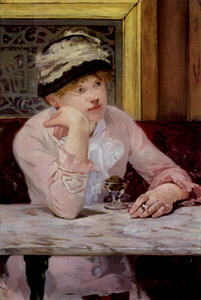EDOUARD MANET

b1832 d1883
Edouard Manet was born in Paris in 1832.After failing examinations for entry into Naval School, he was allowed to take up the study of painting in 1850. However, he soon decided that he could learn more studying Nature and the old Masters than from listening to his teacher, Thomas Couture.
Several of his early paintings were of Spanish subjects, including one that won him an honourable mention at the 1861 Salon. Many contemporaries commented on the evident Spanish influences in his work. However, although Manet had travelled widely in Europe (and once made a trip on a training ship to South America), it was not until 1865 that he saw Spain for himself. The journey increased his admiration for the great Spanish painter, Diego Velasquez and introduced him to the work of Goya. Oddly, though, it also marked the end of his 'Spanish' period. Manet became the centre of a group of artists, such as Degas, Monet, Renoir and Pissarro, who would later be labelled 'Impressionists'. However, Manet did not exhibit at any of the Impressionist exhibitions.
In spite of the scandals caused by his early work, Manet always remained a member of the upper middle class, and always valued respectability. He was never a revolutionary in anything but art. In 1882 he won a medal at the Salon and was made a Chevalier of the Legion of Honour.
A painful disease, thought at first to be rheumatism, turned out to be incurable syphilis and Manet's health declined rapidly. Although barely able to work, he managed to complete one final major work, The Bar at the Folies Bergères.
Edouard Manet died in Paris in April, 1883.